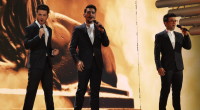
With the deadline ending last night, Czech broadcaster, Česká Televize, has received more than 300 potential Eurovision entries. The style of the entries varies a lot, and most of them are in English, but there are also some in Czech and French.
The “more than 300 entries” matches last year where the country also received “more than 300” songs. For the 2018 selection, the broadcaster added a new rule; that the songs have to be sung by a Czech artist.
The Czech delegation has expressed their excitement over the variety of genres of the submitted entries and also the high interest for the contest among the Czech artists. The broadcaster says that they received songs mostly in English, but also some in Czech and even some in French. The style of the entries also varies a lot. From rock, through country to the current pop and of course ballads, so typical for every Eurovision Songs Contest. The songs were submitted not only from the Czech Republic, but also from foreign composers.
National Selection for Lisbon
From the first information published in the late September and also explained more in the interviews for Czech Eurovision site ESCportal.cz, we have confirmation, that some of the Czech artists submitted their songs to the selection process that is yet to be revealed if it stays internal or if the public will have the opportunity to decide.
The French song in the selection is Septembre by a French singing young artist Annabelle. It is similar to her first single Gabi, according to the information posted by the artist herself. She is one of the artists approached by the broadcaster and asked to submit a song. Another of those artists is YANNA, who previously competed in Hlas Československa. She submitted a song in English, slow tempo and with a piano background. But it is not the only song she has in the selection. The other song is also in English, but faster and modern.
From the guys in the selection, we can name Mikolas Josef. According to Mikolas, he sent the song Lie to Me and it is already on the airplay in the radios. The official video is coming out on the 19th of November. A new name in the selection is then Jakub Ondra, who is a rising star in the Czech Republic. He sings mainly in English and one of his latest singles Cast The Line reminds us of Ed Sheeran. His song in the competition is called Reasons to Love You and according to Jakub, it is one of the catchiest songs he has ever done.
According to Jan Bors, the Head of Delegation, more information should follow in the coming weeks.
Czech Republic at the Eurovision Song Contest
If we compare the previous entries of Czech Republic, this middle European country experimented quite a lot. In 2007 during their debut, Česká Televize sent a rock group Kabát with a song Malá dáma in Czech, who won their national final. One year later in 2008, it was Tereza Kerndlová with the dance-pop song Have Some Fun, who won the national final. The last year before their withdrawal in 2009, it was an internally selected group Gypsy.cz, who sung Aven Romale in a mix of English and Romani. All these three entries ended in or around the bottom of the semifinal scoreboard.
When the Czech Republic returned to Vienna in 2015, they chose internally a pop duet Hope Never Dies by Václav Noid Bárta and Marta Jandová. This was a change in the results from the first three appearances as they ended 13th in their semifinal. So the Czech delegation decided to continue with the internal selection, but they approached composers from all over the Europe and chose Gabriela Gunčíková with a pop ballad I Stand. It was the first time when the Czech Republic qualified to the Grand final.
In 2017, the internal selection continued and the submissions were completely opened to everybody. In the end, Martina Bárta got the ticket to Kyiv with a jazzy pop ballad My Turn. Unfortunately, Martina ended 13th in the semifinal and failed to qualify, but she took part in most of the Eurovision parties over the Europe in April.
In the video below, take a look at the 2017 Czech entry – this time seen from three different angles:



















